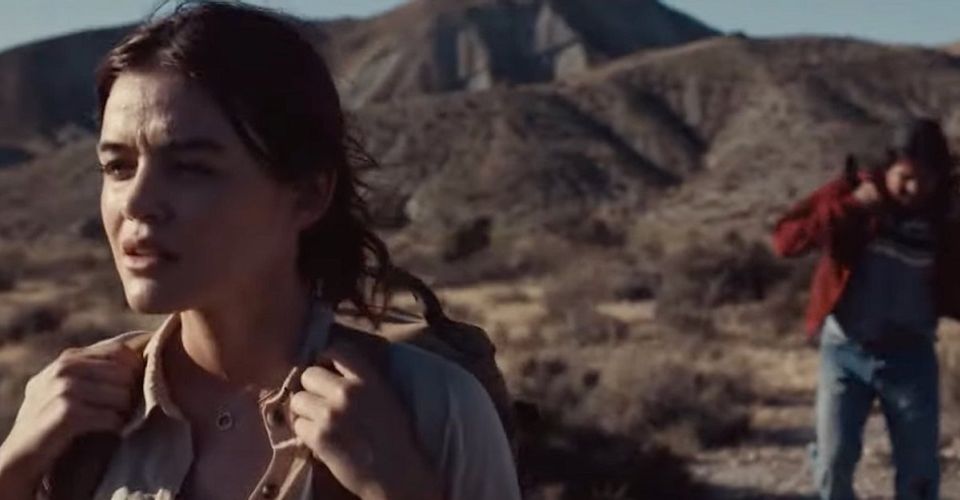Borrego Review: Lucy Hale Leads Thoughtless, Messy & Misguided Thriller

Borrego is a film with an identity crisis. Not entirely the film promised in its opening scroll and it ends up never fully grasping the depth of what it is trying to convey. The opening text of the film references the rise of prescription drug usage, overdoses and drug-related deaths in America. It points to fentanyl and ADHD stimulants as being starting points for this upward trend. It also includes a note about how all of this is impacting the lives of people on the border. Borrego, however, doesn’t meaningfully engage with its set-up and it would have served the plot better if the opening scroll was not included. Borrego, written and directed by Jesse Harris, is misguided and fails to be thought-provoking or contemplative on the matters it seems to be about.
The film follows Elly (Lucy Hale), a botanist who is out in the desert surveying a plant that is not native to it. From the beginning, we are made aware of the fact that Elly is battling some personal demons. Her job turns into a form of personal exile, but then quickly turns into a nightmare. Elly witnesses a plane crash, and when checking on the occupants of the plane discovers a drug mule, Tomas (Leynar Gomez). Elly is now in for the fight of her life as she and Tomas are hunted by cartel member Guillermo (Jorge A. Jimenez).

Borrego primarily deals with, quite honestly, a figment of alarmist ideas. While the border between the United States and Mexico could be a dangerous place (depending on who you are and on what side of the border you reside on), the idea of an innocent bystander witnessing a drug plane crashing and then being caught in a game of life and death plays into the fears of drug trafficking that are often created out of bad faith. Statistics have shown that most trafficking occurs through legal points of entry. This matters because the opening of the film indicates that it will engage with this topic in a meaningful and honest way, but in practice, it only falls into the same stereotypical portrayals of drug trafficking. And that makes Borrego a very uncomfortable watch.
Narratively the film also falters, even without the weight of what it is trying to represent. Elly is a troubled woman who indicates that the use of prescription drugs has had horrible ramifications on her life, but that is never expanded upon or addressed. It feels like there is meant to be some link between her usage of drugs and the drugs that she is now forced to shoulder with Tomas as he forces her to lead him to his destination. On the flip side, we have a harrowing explanation of how Tomas found himself in this position, a backstory that aligns with how many individuals from Latin America are forced into trafficking. However, these thematic pieces never connect nor do they result in a meaningful ending that leaves a lasting impression on the matter. There are loose threads left for audiences to discern whether they should feel as much empathy for Tomas as they do Elly.

Furthermore, it is extremely eye-roll-inducing to witness an exchange that has Elly the botanist explain that she is studying a plant that “shouldn’t be here” and then have Tomas equate that to people like him. Despite decent performances from the leads, the script ultimately fails them. This is the sort of exchange that should have gotten this script shelved. The one thing Borrego does have going for it is Octavio Arias’ cinematography which anchors the film. Through his lens, we see the vastness of the desert and while it may be a breathtaking view, it is never forgotten how dangerous this dry land is. Elly and Tomas’ journey is a treacherous one, even without a cartel member — who, by the way, needlessly kills people as he pursues Tomas and Elly — on their trail. Harris’ directing is also comparable, his steady hand never overplays the drama or the action, easing viewers through each moment of the increasingly precarious situation Elly is in. If only he had a deft hand when writing this script.
As a whole, the film is an overwhelming disappointment. It never feels like it is genuinely engaging with the crisis at hand; rather, fragments of depth flutter about, aimless. Clearly, there is the intention to shine a light on the victims who get brought into these tragic situations, such as Tomas and, to a certain degree, Guillermo. But Harris undercuts those nuanced portrayals by centering on a white American woman who must flee the bad brown Latino man. The bad optics are too overwhelming and stereotypical and can not be overcome to see the heart of what Harris is attempting to do.
There is a reason why conversations about diversity, inclusion, and representation often emphasize the need for behind-the-scenes changes. It is because films like Borrego manage to get produced and they further push outdated ideas, bad optics, and stereotypes that are not adequately dismantled or critiqued within the work itself.
Borrego released in theatres, VOD, and digital platforms on Friday, January 14. The film is 102 minutes long and is rated R for violence and strong language.
- Borrego (2022)Release date: Jan 14, 2022
About The Author

















